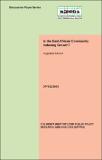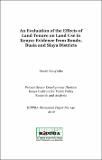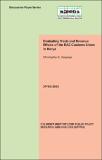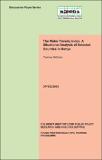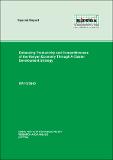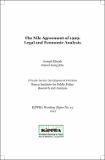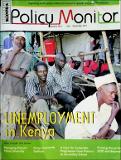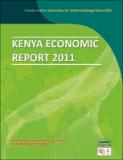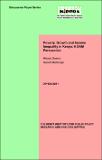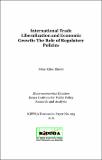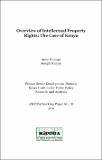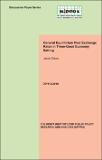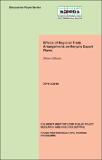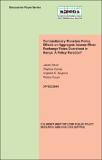3. KIPPRA Research Publications: Recent submissions
Now showing items 481-500 of 708
-
Discussion Paper No. 138 of 2012 on A Review of Various Options for Alleviating Human-Wildlife Conflicts in Kenya.
(The Kenya Institute for Public Policy Research and Analysis (KIPPRA), 2012)Human wildlife conflict is a severe and growing problem in today’s world. Unlike other environmental issues, it involves impoverishment of human communities. It is also causing population declines and may lead to ... -
Discussion Paper No. 137 of 2012 on Violent Victimization in Kenya: Its Nature and Covariates
(The Kenya Institute for Public Policy Research and Analysis (KIPPRA), 2012)Violent victimization among individuals is one of the policy concerns of the Government of Kenya, because it imposes economic, social and physical implications on individuals, society and the country. Establishing a ... -
Discussion Paper No. 132 of 2012 on Is the East African Community Inducing Growth?
(The Kenya Institute for Public Policy Research and Analysis (KIPPRA), 2012)This study investigates the effects of integration process, trade and foreign direct investment (FDI) on economic growth of East African Community (EAC) member countries. Using a panel data and a single equation model, ... -
Discussion Paper No. 140 of 2012 on An Evaluation of the Effects of Land Tenure on Land Use in Kenya: Evidence from Bondo, Busia and Siaya Districts
(The Kenya Institute for Public Policy Research and Analysis (KIPPRA), 2012)Land is an important asset for economic, social and cultural development in Kenya. Agriculture is a key sector in the Kenyan economy, which requires optimal and sustainable use of agricultural land available. Insecure ... -
Discussion Paper No. 142 of 2012 on Effects of Financial Literacy on Financial Access in Kenya
(The Kenya Institute for Public Policy Research and Analysis (KIPPRA), 2012)This study investigates effects of financial literacy on financial access in Kenya. The FinAccess National Survey 2009 shows that 60 per cent of the adult population in Kenya lacks access to formal financial services ... -
Discussion Paper No. 131 of 2012 on Evaluating Trade and Revenue Effects of the EAC Customs Union in Kenya
(The Kenya Institute for Public Policy Research and Analysis (KIPPRA), 2012)This study examines the impact of the EAC customs union on trade, revenue and welfare on the Kenyan economy over the 5-year transitional period. Using a simple partial equilibrium method to measure static effects, the ... -
Discussion Paper No. 133 of 2012 on The Water Poverty Index: A Situational Analysis of Selected Counties in Kenya.
(The Kenya Institute for Public Policy Research and Analysis (KIPPRA), 2012)Kenya is a water scarce country, and this impacts on the social and economic development goals. This study seeks to develop a Water Poverty Index to assess water resources at the county level. The Water Poverty Index ... -
Discussion Paper No. 139 of 2012 on Effects of Minimum Wage on Gendered Employment in Kenya
(The Kenya Institute for Public Policy Research and Analysis (KIPPRA), 2012)This study utilizes time series data to analyze the effects of minimum wage on females and males in formal employment in Kenya. Time series data from 1973 to 2009 is analyzed for long run and short run effects of minimum ... -
Special Paper No. 13 of 2012 on Enhancing Productivity and Competitiveness of the Kenyan Economy Through a Cluster Development Strategy
(The Kenya Institute for Public Policy Research and Analysis (KIPPRA), 2012)The world economy is undergoing rapid change associated with globalization and liberalization, which has increased the need for industrial competitiveness. Kenya ranks low in global competitiveness and compares ... -
Working Paper No. 19 of 2012 on The Nile Agreement of 1929: Legal and Economic Analysis
(The Kenya Institute for Public Policy Research and Analysis (KIPPRA), 2012)The Nile Agreement of 1929 established two substantive rules. First, it granted Egypt the exclusive property rights over the waters of the River Nile based on prior use. According to Coasian analysis, such a framework ... -
Policy Monitor, Issue 4 No. 1, July-September 2011 on Unemployment in Kenya
(The Kenya Institute for Public Policy Research and Analysis (KIPPRA), 2011)In many countries, long term unemployment and underemployment continue to soar. The unemployment rate of youth agl'd 15-24 in Kenya was 24% in 2005/6 compared to the overall unemployment rate of 12.7%. Under-employment ... -
Discussion Paper No. 127 of 2011 on The Effect of Infrastructure on Foreign Direct Investment in Kenya
(The Kenya Institute for Public Policy Research and Analysis (KIPPRA), 2011)This study investigates the effect of infrastructure on foreign direct investment (FDI) in Kenya from 1980-2008. An index of infrastructure was constructed using sub-indicators from energy, transport and communication ... -
Kenya Economic Report 2011 on Transformative Institutions for Delivering Kenya Vision 2030
(The Kenya Institute for Public Policy Research and Analysis (KIPPRA), 2011)The Kenya Economic Report (KER) 2011 is the third in a series of annual reports on the Kenyan economy prepared by the Kenya Institute for Public Policy Research and Analysis (KIPPRA) pursuant to the KIPPRA Act No. 15 of ... -
Discussion Paper No. 126 of 2011 on Is There a Real Estate Market Boom or Bubble in Urban Kenya? A Case Study of Residential Real Estate in Nairobi Metropolitan Region
(The Kenya Institute for Public Policy Research and Analysis (KIPPRA), 2011)Real estate is a basic need and the largest component of human wealth. Therefore, a change in real estate prices has a significant impact on individuals’ welfare and investment decisions. In Kenya, and particularly Nairobi ... -
Discussion Paper No. 124 of 2011 on Poverty, Growth and Income Inequality in Kenya: a SAM Perspective
(The Kenya Institute for Public Policy Research and Analysis (KIPPRA), 2011)This study seeks to highlight the levels of income inequality in Kenya and its implications on various policy options targeted at reducing poverty. The 2003 Kenya SAM is used to develop a multiplier simulation model, which ... -
Discussion Paper No. 125 of 2011 on Liberalization and Economic Growth: The Role of Regulatory Policies
(The Kenya Institute for Public Policy Research and Analysis (KIPPRA), 2011)This study investigates the relationship between international trade liberalization and economic growth, with a focus on the role of regulatory policies in selected 16 sub-Saharan Africa (SSA) countries. It seeks to examine ... -
Working Paper No. 18 of 2011 on Overview of Intellectual Property Rights: The Case of Kenya
(The Kenya Institute for Public Policy Research and Analysis (KIPPRA), 2011)Theory and experiences amongst the Asian Tigers reveal that knowledge has an important role to play in promoting economic growth. Knowledge however, is a non-rival good with partial excludable characteristics. Intellectual ... -
Discussion Paper No. 110 of 2010 on General Equilibrium Real Exchange Rates in Three-Good Economy Setting
(The Kenya Institute for Public Policy Research and Analysis (KIPPRA), 2010)This study develops a theoretical general equilibrium model of the determination of the equilibrium long-run real exchange rates in a three-good open economy framework. Three economic agents are considered in the model: ... -
Discussion Paper No. 113 of 2010 on Effects of Regional Trade Arrangements on Kenya's Export Flows
(The Kenya Institute for Public Policy Research and Analysis (KIPPRA), 2010)Kenya’s bilateral exports were positively affected by its productive capacity, absorptive capacity of its trading partners, and Kenya’s increased involvement in regional integration. Progression of COMESA from Preferential ... -
Discussion Paper No. 123 of 2010 on Contractionary Monetary Policy Effects on Aggregate Income when Exchange Rates Overshoot in Kenya: a Policy Paradox?
(The Kenya Institute for Public Policy Research and Analysis (KIPPRA), 2010)With the liberalization of the exchange rate market in Kenya, it is expected that contractionary monetary policy meant to reduce inflation will lead to exchange rate overshooting. Exchange rate overshooting on the other ...



